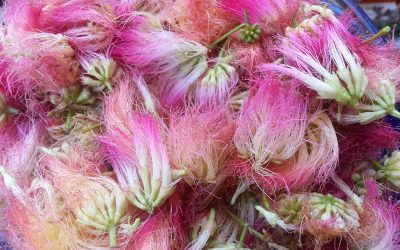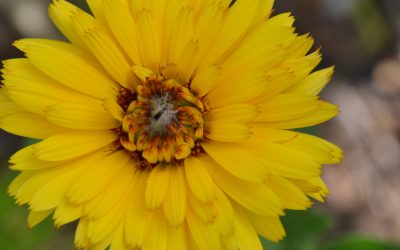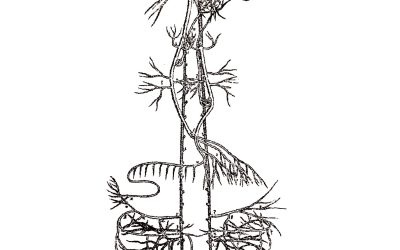Herbal Shorts from the Rio Grande Bosque
by Dara Saville 
If you haven’t figured out that I love the Rio Grande Bosque by now, you are falling behind. I’ve already written about lovely Yerba Mansa and her companion Cottonwood, but what about all those other plants hiding away in the understory? The understory of the Middle Rio Grande Bosque can be quite varied. Some places far enough downstream from Cochiti Dam are more wild and jungle-like with lower riverbanks and side channels of water that nourish the health of the ecosystem. Meanwhile in other places, including much of the Rio Grande Valley State Park within the city limits of Albuquerque, the understory is often open with few plants to speak of or it is covered in weedy non-natives such as the dreaded prickly Kochia. Furthermore, the Bosque is a mosaic of differing habitat types including native Cottonwood stands, invasive Salt Cedar stands, open areas, riverbanks and sandbars, and wetlands. ?Exploring the healthier areas of this ecosystem brings unexpected experiences like feeling lost within a rare urban wilderness area or discovering hidden jewels within the dense off-trail vegetation. Here is a small selection of those treasured plants of our wild Bosque:
.
Blue Lettuce (Mulgedium pulchellum or Lactuca tatarica var. pulchella): Blue Lettuce is a native sister of the more common non-native weed Lactuca serriola, or Wild Lettuce, and is present across much of North America. Both share many common attributes including bleeding a milky sap with medicinal properties. This sap is captured in fresh herb tinctures made from all parts of the plant (especially leaves, and stems) and used as part of formulas for promoting restful sleep, calming bodily spasms, relaxing tension and anxiety, coughing, and even acts as a mild pain reliever. Additionally Blue Lettuce is a tasty wild green when collected early in the spring.
pulchellum or Lactuca tatarica var. pulchella): Blue Lettuce is a native sister of the more common non-native weed Lactuca serriola, or Wild Lettuce, and is present across much of North America. Both share many common attributes including bleeding a milky sap with medicinal properties. This sap is captured in fresh herb tinctures made from all parts of the plant (especially leaves, and stems) and used as part of formulas for promoting restful sleep, calming bodily spasms, relaxing tension and anxiety, coughing, and even acts as a mild pain reliever. Additionally Blue Lettuce is a tasty wild green when collected early in the spring.
.
Pale Wolfberry (Lycium pallidum): This powerful member of the Solanaceae family is a  medicinal shrub related to the more famous Goji berry. Wolfberry, however, should be used in moderation and works well in formulas where the dosage will be smaller. Too much of this plant can create imbalance, dryness, and heat, exactly what we don’t need here in the Southwest. It combines well with other herbs that get at the root causes of illness while Wolfberry eases symptoms. Collect the leaves for tincturing or keep some stored dry to reconstitute for topical applications. The latter comes in handy for the pain and swelling that often comes with summertime’s bites, stings, and rashes. In that case, you can mix the powdered herb with some clay and water or just water to make a nice soothing paste. Wolfberry also works in the respiratory system by opening chest congestion and drying the wetness of allergies. It is also an effective anti-spasmodic in the digestive system.
medicinal shrub related to the more famous Goji berry. Wolfberry, however, should be used in moderation and works well in formulas where the dosage will be smaller. Too much of this plant can create imbalance, dryness, and heat, exactly what we don’t need here in the Southwest. It combines well with other herbs that get at the root causes of illness while Wolfberry eases symptoms. Collect the leaves for tincturing or keep some stored dry to reconstitute for topical applications. The latter comes in handy for the pain and swelling that often comes with summertime’s bites, stings, and rashes. In that case, you can mix the powdered herb with some clay and water or just water to make a nice soothing paste. Wolfberry also works in the respiratory system by opening chest congestion and drying the wetness of allergies. It is also an effective anti-spasmodic in the digestive system.
 American Licorice (Glycyrrhiza lepidota): Our native Licorice is a frequent find when walking through the Bosque or along Albuquerque’s acequia system (irrigation ditches that carry water throughout the valley). Often this plant grows in compacted soils, which makes digging the roots a difficult chore. Unlike other species of Licorice, ours contains little glycyrrhizin and lacks the super-sweet flavor that typifies this plant. This may be a benefit for those who do not care for the flavor of purchased varieties of Licorice or for those who have contraindications to using this plant. (Usual contraindications include high blood pressure, edema, and diabetes.) Licorice has been used for centuries (or longer) for the treatment of a long list of health conditions including all kinds of inflammations and viral infections, especially coughs and sore throats. Like other members of the Legume family, Licorice has an important ecological role to play though its symbiotic relationship with soil bacteria and by fixing nitrogen in the soil.
American Licorice (Glycyrrhiza lepidota): Our native Licorice is a frequent find when walking through the Bosque or along Albuquerque’s acequia system (irrigation ditches that carry water throughout the valley). Often this plant grows in compacted soils, which makes digging the roots a difficult chore. Unlike other species of Licorice, ours contains little glycyrrhizin and lacks the super-sweet flavor that typifies this plant. This may be a benefit for those who do not care for the flavor of purchased varieties of Licorice or for those who have contraindications to using this plant. (Usual contraindications include high blood pressure, edema, and diabetes.) Licorice has been used for centuries (or longer) for the treatment of a long list of health conditions including all kinds of inflammations and viral infections, especially coughs and sore throats. Like other members of the Legume family, Licorice has an important ecological role to play though its symbiotic relationship with soil bacteria and by fixing nitrogen in the soil.
.
Canadian Fleabane (Conyza canadensis): I did not intend to discuss weed species in this  post, but I could not resist including this abundant and useful native that is so widespread in the Bosque as well as other areas across the entire continent. The upper leaves of this plant make useful digestive remedies, especially for chronic inflammatory issues, leaky gut, diarrhea, and indigestion. This plant has a unique spicy flavor and can be used to create interesting culinary creations in your kitchen. One of my favorite ways to prepare it is to infuse the leaves in oil or vinegar and use it for medicinal foods, salad dressings, and marinades.
post, but I could not resist including this abundant and useful native that is so widespread in the Bosque as well as other areas across the entire continent. The upper leaves of this plant make useful digestive remedies, especially for chronic inflammatory issues, leaky gut, diarrhea, and indigestion. This plant has a unique spicy flavor and can be used to create interesting culinary creations in your kitchen. One of my favorite ways to prepare it is to infuse the leaves in oil or vinegar and use it for medicinal foods, salad dressings, and marinades.
.
Japanese Honeysuckle (Lonicera japonica): It seems that every environment in this modern global era must be defined, in part, by the invasive non-natives. That’s why I am including one of them here for the Bosque and believe me there are many to choose from. Besides we can do the ecosystem a favor by harvesting the invaders’ flowers. Honeysuckle flowers are cooling for hot inflamed conditions and provide antibacterial and antiviral power. Prepare as tincture, tea, glycerite, or infused honey.
Continue on this topic with my featured photography and writing: Visions and Voices of the Bosque.
blank
References
As usual, the information included in this post is derived from a combination of research and personal experience. References consulted:
- Charles Kane, Medicinal Plants of the American Southwest, (Lincoln Town Press, 2011).
- Jean-Luc E. Cartron, David C. Lightfoot, Jane E. Mygatt, Sandra L. Brantley, and Timothy K. Lowry, A Field Guide to the Plants and Animals of the Middle Rio Grande Bosque, (Albuquerque: University of New Mexico Press, 2008).
- Michael Moore, Medicinal Plants of the Mountain West, (Santa Fe NM: Museum of New Mexico Press, 2003).
- William Dunmire and Gail Tierney. Wild Plants of the Pueblo Province (Santa Fe NM: Museum of New Mexico Press, 1995).




